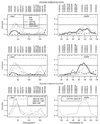Susceptibility loci for adiposity phenotypes on 8p, 9p, and 16q in American Samoa and Samoa
- PMID: 19238140
- PMCID: PMC2879592
- DOI: 10.1038/oby.2008.558
Susceptibility loci for adiposity phenotypes on 8p, 9p, and 16q in American Samoa and Samoa
Abstract
Obesity is a complex phenotype affected by genetic and environmental influences such as sociocultural factors and individual behaviors. Previously, we performed two separate genome-wide investigations for adiposity-related traits (BMI, percentage body fat (%BF), abdominal circumference (ABDCIR), and serum leptin and serum adiponectin levels) in families from American Samoa and in families from Samoa. The two polities have a common evolutionary history but have lately been influenced by variations in economic development, leading to differences in income and wealth and in dietary and physical activity patterns. We now present a genome-wide linkage scan of the combined samples from the two polities. We adjust for environmental covariates, including polity of residence, education, cigarette smoking, and farm work, and use variance component methods to calculate univariate and bivariate multipoint lod scores. We identified a region on 9p22 with genome-wide significant linkage for the bivariate phenotypes ABDCIR-%BF (1-d.f. lod 3.30) and BMI-%BF (1-d.f. lod 3.31) and two regions with genome-wide suggestive linkage on 8p12 and 16q23 for adiponectin (lod 2.74) and the bivariate phenotype leptin-ABDCIR (1-d.f. lod 3.17), respectively. These three regions have previously been reported to be linked to adiposity-related phenotypes in independent studies. However, the differences in results between this study and our previous polity-specific studies suggest that environmental effects are of different importance in the samples. These results strongly encourage further genetic studies of adiposity-related phenotypes where extended sets of carefully measured environmental factors are taken into account.
Conflict of interest statement
The authors declared no conflict of interest.
Figures


References
-
- Bell CG, Walley AJ, Froguel P. The genetics of human obesity. Nat Rev Genet. 2005;6:221–234. - PubMed
-
- Hedley AA, Ogden CL, Johnson CL, Carroll MD, Curtin LR, Flegal KM. Prevalence of overweight and obesity among US children, adolescents, and adults, 1999–2002. JAMA. 2004;291:2847–2850. - PubMed
-
- Popkin BM, Gordon-Larsen P. The nutrition transition: worldwide obesity dynamics and their determinants. Int J Obes Relat Metab Disord. 2004;28 Suppl 3:S2–S9. - PubMed
-
- Keighley ED, McGarvey ST, Turituri P, Viali S. Farming and adiposity in Samoan adults. Am J Hum Biol. 2006;18:112–122. - PubMed
-
- Swinburn BA, Ley SJ, Carmichael HE, Plank LD. Body size and composition in Polynesians. Int J Obes Relat Metab Disord. 1999;23:1178–1183. - PubMed
Publication types
MeSH terms
Substances
Grants and funding
LinkOut - more resources
Full Text Sources
Miscellaneous

